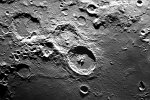Fracastorius, Piccolomini and the Altai
Scarp
are beautiful in any kind of light, but on 6/6 at around 9:30,
at very early sunrise when only part of the Scarp was illuminated,
I caught some other weird phenomena: a very prominent ridge extending
out from Beaumont, unnamed in Rukl, which I will take the liberty of
calling Dorsa Beaumont, and an
interesting W-shaped pattern extending into the terminator which turned
out to be the well-known trio of Catharina just beginning to
poke into the light.
See also the discussion of their possible relation to Mare Nectaris
on chart 57,
and Morio Higashida's
image of
Theophilus, Cyrillus, and Catharina.
Hypatia has a break in its
eastern wall, and at about 8pm PST (on 3/4/98), a thin ray was just beginning to
spill through the gap in the wall and all the way across the crater
floor to the other side, where another break in the wall, just south of
where the ray ended, created a second ray streaming out of Hypatia onto
the terrain west of the crater. It was a lovely sight -- the best lunar
ray I've observed so far.
![[Dorsa Beaumont, etc.]](../images/sketch/beaumontT.jpg)
 Thierry Legault's
CCD image of craters Theophilus (bottom left), Cyrillus (bottom center),
and Catharina (top right).
Thierry Legault's
CCD image of craters Theophilus (bottom left), Cyrillus (bottom center),
and Catharina (top right).